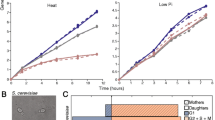Abstract
In the yeast Saccharomyces cerevisiae the ade2, and/or the ade1, mutation in the adenine biosynthetic pathway leads to the accumulation of a cell-limited red pigment, while epistatic mutations in the same pathway, i.e. ade8, preclude this phenomenon, resulting in normal white colonies. The shift in color from red to white (or vice versa) with a combination of appropriate wild-type and mutant alleles of the adenine-pathway genes has been widely utilized as a non-selective phenotype to visualise and quantify the occurrence of various genetic events such as recombination, conversion and aneuploidy. It has provided an invaluable tool for the study of gene dosage and plasmid stability. In competition experiments between disrupted ade2, ade8-18 transformants carrying either a functional or non-functional episomal ADE8 gene, we verified that white ade8 ade2 cells show a remarkable selective advantage over red ade2 cells, with important implications on the use of this assay for the monitoring of genetic events. The accumulation of the red pigment in ade2 cells is likely to be the cause for impaired growth in these cells.
Similar content being viewed by others
Author information
Authors and Affiliations
Additional information
Received: 15 June / 15 August 1996
Rights and permissions
About this article
Cite this article
Ugolini, S., Bruschi, C. The red/white colony color assay in the yeast Saccharomyces cerevisiae: epistatic growth advantage of white ade8-18, ade2 cells over red ade2 cells. Curr Genet 30, 485–492 (1996). https://doi.org/10.1007/s002940050160
Issue Date:
DOI: https://doi.org/10.1007/s002940050160



